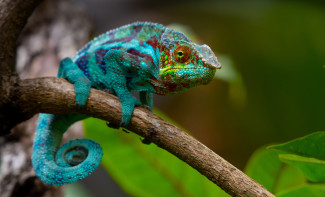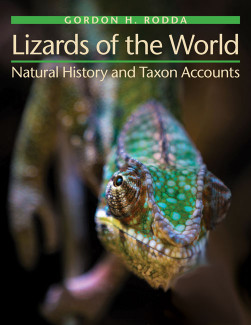
Johns Hopkins UniversityEst. 1876
America’s First Research University
Now Browsing:
Lizards of the World

Herpetologists have no idea how many lizard species there are. When I started planning Lizards of the World there were about 3000 species known worldwide. When I finished my data collection there were 6528; now there are over 7100. Is the true number 10,000 or 50,000? We are gaining about one formally described lizard species a day; taxonomic discoveries have never been faster. But how many lizard species are we losing at the same time?
About half of all lizard species are imperiled by some criterion. Extinction estimates of 30% or more this century have been predicted in high-credibility journals. Invasive species, habitat loss, and climate change are the usual culprits. In general, the dire climate change predictions of the scientific community have not been met, but rather surpassed. In 2020, for example, the predicted 2050 annual acreage lost to wildfires in California was surpassed, 30 years sooner than expected. Given the physics of climate change, our best near-term hope is that the rate of temperature increase will decelerate. We can hope that humanity will suddenly embrace radical shifts in the global economy to preserve a livable planet, but covid experience suggests that compliance with even small requests for human behavioral change will be opposed with lethal ferocity.
Ecologists realize that they do not know enough about ecosystems to adequately predict or ameliorate future changes. Will ecosystems hold together and shift their distributions toward the poles quickly enough to remain within shifting climate envelopes? Will species instead perish because they get ecologically separated from the prey and commensal species on which they depend? Will emerging lizard diseases decimate the survivors? Will habitats be destroyed by long-term droughts and fires? How do ecosystems fall apart? To answer these questions, one needs to understand the ecologies of the constituent species.
We don’t. Only about one-quarter (27%) of the most fundamental ecological traits of lizard species have been described or even speculated upon. For particularly well-studied groups like Anolis lizards, we are ignorant of what 65% of them eat. The genetic relationships among species are rapidly coming into focus, and superb web sites exist to tabulate taxonomic and genetic discoveries in real-time, but natural history and applied ecology are not the stuff pursued by striving scientists. Except for Caribbean islands, no compendium of herpetological natural histories has been prepared, and it is unlikely that a university scientist would be granted tenure for doing so.

We need natural history information, if only to understand retrospectively why ecosystems collapse. The time remaining to study these systems is measured not in decades but in years, as ecosystems worldwide are contorted into systems that behave inexplicably because they are no longer operating within the bounds in which they evolved.
For example, we need to understand the selective forces that crafted the natural history patterns we see. Exactly how large are the predation pressures on a given lizard species? How does predation vary with the age of the lizard (these factors affect clutch counts, frequency of reproduction, and growth rates, etc.)? For which species does diet really matter (most lizards seem to be dietary opportunists)? How high a prey density is needed for a sit-and-wait lizard population to survive? What is already known?
Lizards of the World is a place to start. Unlike any previous work of its geographic scope, it does not focus on taxonomy, phylogeny, or genetics. It covers the whole context of biology, by asking what happens in nature. I was surprised by many of the trait distributions I tabulated. The median lizard weighs less than 5 grams (a traditional metal paperclip weighs about 1 g). Big flashy lizards grab researchers’ attention, but most lizards are cryptic, hidden, or inconspicuous. About one-third of species hide in trees; more than one-sixth hide in litter or remain motionless in plain view; one-tenth live underground. Only about one-third are visible to a casual observer. Even the “flying” lizards, which glide from tree to tree and flash their enormous dewlaps and gaudy wing membranes, can disappear in an instant by dodging into vegetation and folding their brightly colored surfaces.
Although many physiologists have focused on sprint speed as a vital component of lizard survival, I was surprised to learn how many lizards specialize in moving slowly. Many of the slow movers are nocturnal and evidently do not want to make noises that would tip off predators. Some slow movers are nearly immobile; they disappear through crypsis. Often, slow movers live in leaf litter and do not want to draw attention to themselves by rustling fallen leaves.
These facts are tabulated in Lizards of the World. I hope that all nature lovers, but especially graduate students, will find among the hundreds of previously underappreciated phenomena one that will stir their scientific juices and get them out in nature watching, while they still have the opportunity.
Order Lizards of the World: Natural History and Taxon Accounts – published on September 1, 2020 – at the following link: https://jhupbooks.press.jhu.edu/title/lizards-world
Gordon H. Rodda is a zoologist emeritus at the United States Geological Survey's Fort Collins Science Center. He is the author of Lizards of the World: Natural History and Taxon Accounts and a coeditor of Problem Snake Management: The Habu and Brown Treesnake.

About half of all lizard species are imperiled by some criterion. Extinction estimates of 30% or more this century have been predicted in high-credibility journals. Invasive species, habitat loss, and climate change are the usual culprits. In general, the dire climate change predictions of the scientific community have not been met, but rather surpassed. In 2020, for example, the predicted 2050 annual acreage lost to wildfires in California was surpassed, 30 years sooner than expected. Given the physics of climate change, our best near-term hope is that the rate of temperature increase will decelerate. We can hope that humanity will suddenly embrace radical shifts in the global economy to preserve a livable planet, but covid experience suggests that compliance with even small requests for human behavioral change will be opposed with lethal ferocity.
Ecologists realize that they do not know enough about ecosystems to adequately predict or ameliorate future changes. Will ecosystems hold together and shift their distributions toward the poles quickly enough to remain within shifting climate envelopes? Will species instead perish because they get ecologically separated from the prey and commensal species on which they depend? Will emerging lizard diseases decimate the survivors? Will habitats be destroyed by long-term droughts and fires? How do ecosystems fall apart? To answer these questions, one needs to understand the ecologies of the constituent species.
We don’t. Only about one-quarter (27%) of the most fundamental ecological traits of lizard species have been described or even speculated upon. For particularly well-studied groups like Anolis lizards, we are ignorant of what 65% of them eat. The genetic relationships among species are rapidly coming into focus, and superb web sites exist to tabulate taxonomic and genetic discoveries in real-time, but natural history and applied ecology are not the stuff pursued by striving scientists. Except for Caribbean islands, no compendium of herpetological natural histories has been prepared, and it is unlikely that a university scientist would be granted tenure for doing so.

We need natural history information, if only to understand retrospectively why ecosystems collapse. The time remaining to study these systems is measured not in decades but in years, as ecosystems worldwide are contorted into systems that behave inexplicably because they are no longer operating within the bounds in which they evolved.
For example, we need to understand the selective forces that crafted the natural history patterns we see. Exactly how large are the predation pressures on a given lizard species? How does predation vary with the age of the lizard (these factors affect clutch counts, frequency of reproduction, and growth rates, etc.)? For which species does diet really matter (most lizards seem to be dietary opportunists)? How high a prey density is needed for a sit-and-wait lizard population to survive? What is already known?
Lizards of the World is a place to start. Unlike any previous work of its geographic scope, it does not focus on taxonomy, phylogeny, or genetics. It covers the whole context of biology, by asking what happens in nature. I was surprised by many of the trait distributions I tabulated. The median lizard weighs less than 5 grams (a traditional metal paperclip weighs about 1 g). Big flashy lizards grab researchers’ attention, but most lizards are cryptic, hidden, or inconspicuous. About one-third of species hide in trees; more than one-sixth hide in litter or remain motionless in plain view; one-tenth live underground. Only about one-third are visible to a casual observer. Even the “flying” lizards, which glide from tree to tree and flash their enormous dewlaps and gaudy wing membranes, can disappear in an instant by dodging into vegetation and folding their brightly colored surfaces.
Although many physiologists have focused on sprint speed as a vital component of lizard survival, I was surprised to learn how many lizards specialize in moving slowly. Many of the slow movers are nocturnal and evidently do not want to make noises that would tip off predators. Some slow movers are nearly immobile; they disappear through crypsis. Often, slow movers live in leaf litter and do not want to draw attention to themselves by rustling fallen leaves.
These facts are tabulated in Lizards of the World. I hope that all nature lovers, but especially graduate students, will find among the hundreds of previously underappreciated phenomena one that will stir their scientific juices and get them out in nature watching, while they still have the opportunity.
Order Lizards of the World: Natural History and Taxon Accounts – published on September 1, 2020 – at the following link: https://jhupbooks.press.jhu.edu/title/lizards-world
Gordon H. Rodda is a zoologist emeritus at the United States Geological Survey's Fort Collins Science Center. He is the author of Lizards of the World: Natural History and Taxon Accounts and a coeditor of Problem Snake Management: The Habu and Brown Treesnake.

Login to View & Leave Comments
Login to View & Leave Comments


